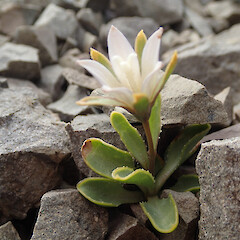Wahlenbergia cartilaginea
Common name
scree harebell
Family
Campanulaceae
Flora category
Vascular – Native
Endemic taxon
Yes
Endemic genus
No
Endemic family
No
Structural class
Herbs - Dicotyledons other than Composites
NVS code
The National Vegetation Survey (NVS) Databank is a physical archive and electronic databank containing records of over 94,000 vegetation survey plots - including data from over 19,000 permanent plots. NVS maintains a standard set of species code abbreviations that correspond to standard scientific plant names from the Ngä Tipu o Aotearoa - New Zealand Plants database.
WAHCAR
Chromosome number
2n = 36
Current conservation status
The conservation status of all known New Zealand vascular plant taxa at the rank of species and below were reassessed in 2017 using the New Zealand Threat Classification System (NZTCS) – more information about this can be found on the NZTCS website. This report includes a statistical summary and brief notes on changes since 2012 and replaces all previous NZTCS lists for vascular plants.
Please note, threat classifications are often suggested by authors when publications fall between NZTCS assessment periods – an interim threat classification status has not been assessed by the NZTCS panel.
- Conservation status of New Zealand indigenous vascular plants, 2017 . 2018. Peter J. de Lange, Jeremy R. Rolfe, John W. Barkla, Shannel P. Courtney, Paul D. Champion, Leon R. Perrie, Sarah M. Beadel, Kerry A. Ford, Ilse Breitwieser, Ines Schönberger, Rowan Hindmarsh-Walls, Peter B. Heenan and Kate Ladley. Department of Conservation. Source: NZTCS and licensed by DOC for reuse under the Creative Commons Attribution 4.0 International licence.
2017 | At Risk – Naturally Uncommon | Qualifiers: Sp
Previous conservation statuses
2012 | At Risk – Naturally Uncommon | Qualifiers: Sp
2009 | At Risk – Naturally Uncommon
2004 | Range Restricted
Distribution
Endemic. New Zealand: South Island (Inland Kaikoura and Amuri Ranges from Mt Tapuaenuku to Mt Terako and Mt Percival, and drainage areas of upper Wairau, Waiau, Clarence, and Awatere Rivers)
Habitat
Mostly subalpine to alpine (rarely within montane areas on shingle beds and slips along riversides). Endemic to deep fine greywacke screes and semi-consolidated debris slopes.
Detailed description
A perennial deep-rooting rhizomatous scree plant with distant rosettes of very thick, glaucous, (sometimes yellowish) sessile leaves, glabrous or pubescent. Leaves 8 × 5-25 × 15 mm, spathulate, obtuse, narrowed to a thick flat petiole; margins entire, thickened, cartilaginous. Scapes 20-30 mm long, stout, glaucous, with 1-3 small bracts, usually simple and stiff. Flower Insect-pollinated, c.12 mm long, 8-12 mm diameter, lilac or white, scented. Corolla broadly funnel-shaped, 5-partite, tube c.5 × 6 mm, lobes c. 7 × 5 mm, enclosed within the large calyx lobes which are thick and coriaceous, glabrous, linear-oblong, obtuse, 6 × 2 to 10 × 3 mm. Capsule glabrous, often glaucous, globose to broadly turbinate, c.8 × 8 to 10 × 10 mm. Seeds larger than in other species, 1 mm long, ellipsoid, glossy brown when mature.
Similar taxa
Easily separated from other Wahlenbergia Roth by its restriction to mobile scree habitats; its thick greyish or yellowish leaves borne in widely spaced, separate rosettes; short thick flower stems, calyx lobes about as long as the corolla, and by its fragrant insect-pollinated flowers.
Flowering
December - January
Flower colours
Violet/Purple, White
Fruiting
January - March
Propagation technique
Can be grown in a rockery or an alpine house but generally regarded as difficult. Best from fresh seed.
Threats
A naturally uncommon, narrow range endemic that is sparsely distributed over a wide area of scree in eastern Marlborough. Although not considered threatened, some populations suffer from browsing by sheep, goats, rabbits, hares, and other livestock.
Etymology
wahlenbergia: Named in honour of Wahlenberg, a Swedish botanist and author of A Botany of Lapland.
cartilaginea: Like cartilage
Where To Buy
Not Commercially Available
Attribution
Fact Sheet Prepared by P.J. de Lange 12 June 2007. Description adapted from Petterson (1997).
References and further reading
Petterson, J.A. 1997: Revision of the genus Wahlenbergia (Campanulaceae) in New Zealand. New Zealand Journal of Botany 35: 9-54.
NZPCN Fact Sheet citation
Please cite as: de Lange, P.J. (Year at time of access): Wahlenbergia cartilaginea Fact Sheet (content continuously updated). New Zealand Plant Conservation Network. https://www.nzpcn.org.nz/flora/species/wahlenbergia-cartilaginea/ (Date website was queried)










